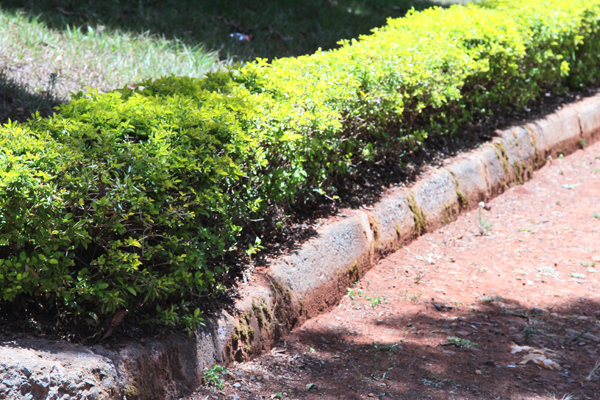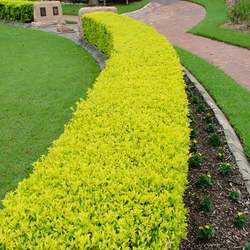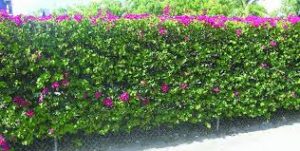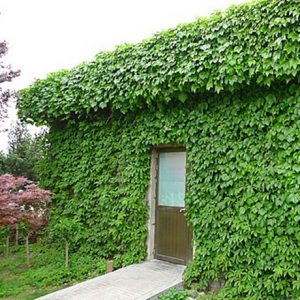There are various ways of beautifying your compound, and one of these is having a healthy-looking, well-maintained hedge. Hedges, or hedgerows, come in various forms, including flowering plants, herbaceous varieties, vines, shrubs and hardy types, trees and even grasses.
Some hedges are best suited for wet regions while others thrive in semi-arid conditions. Some require constant application of fertiliser, while for others, the nutrients in the soil are sufficient.
Ms Celia Hardy of Plants Galore says it is advisable to critically study the plant you want for your hedge to determine the ideal conditions for it.
“As a homeowner, don’t be afraid to ask your plant dealer those incisive questions. An honest dealer will provide the correct information about the plants you are buying. You don’t want to sink your money into a plant that either dies or gives you undesirable results,” she says.
Below are some of the common plants used for hedges in Kenya.
Duranta
It is the commonest plant used for hedges in Kenyan homes. There are about 17 species of the duranta, but the most common ones locally are the golden yellow, green and variegated varieties.
“Duranta is the fastest growing type of hedge in Kenya, but it is also a very untidy type of hedge if not well tended,” says Ms Hardy. She adds that the variegated species is the least preferred by most homeowners. “For lack a green colouring matter, the plant withers and dies eventually,” she offers.
Miniature bamboo
Many people are familiar with fencing using dry bamboo. However, green bamboo can be also used.
“You must be careful about the bamboo species you are introducing because some varieties grow wildly, with a huge network of roots fast spreading to other areas, which could trigger conflict with neighbours. However, the miniature bamboo is restrictive, and grows in an orderly fashion., says Ms Hardy.
Plumbago
This plant, also called Cape Royal because it is native to South Africa, is easily identifiable by its usually sprawling mass of beautiful flowers. The plumbago is liked for its ability to thrive even in fairly poor soils and its resistance to pests. It has blue and white flowers and blossoms best after pruning.
“Plumbago does well even in the shade, and being a fast-growing variety, regular pruning helps to keep it in excellent shape,” says Ms Hardy.
When buying hedge plants, she advises, go for hardy varieties that can endure dry spells, saving you from having to water them regularly.
Bougainvillea
There are more than 50 different species, including the purple-flower variety with smaller leaves and fewer flowers. You can choose between either the flowery or leafy a type. “If you trim the hedge, it loses the flowers, if you allow it to grow freely, it produces flowers but loses form. It’s upon you to determine what appeals more to you,” says Ms Hardy, adding, “The less water it has, the more flowers it produces.”
Many people like the bougainvillaea because it is highly drought resistant.
Creepers
Ms Hardy says that growing a hedge using one species creates monotony, so combining different types can be used to great effect.
“Blending plumbago with the duranta especially produces a chic look. Creepers such as ivy do well when paired with hardy hedge plants that act as their host. Their intertwining nature also makes the hedge impenetrable,” she says.
However, she cautions, some creepers are so aggressive that they outgrow their host and take over. This prevents the host from receiving direct sunlight, which sometimes causes its leaves to turn yellow. Ideally, creepers should be planted several metres from the base of the host to prevent persistent competition for nutrients.
Ms Hardy says that some plants do more than just lend elegance to a home. “The obvious use of hedges is to separate properties. Hedges also serve as wind breakers. Some, such as the kei apple, produce fruit, which makes a very delicious jelly for roast beef,” she says.
Maintaining your hedge
For a healthy good-looking hedge, Ms Hardy advises the application of manure, bone meal and compost. “Why do people eat breakfast, lunch and dinner every day but forget that plants also need to feed? Most people buy plants, stuff them in red soil and sit back to wait for magical results,” she notes.
However, she cautions against applying di-ammonium phos,phate (DAP) fertilisers on hedges, or applying them during the dry season. “This fertiliser requires a lot of water to be absorbed. If you apply it during the dry spell, you end up scorching the plants.”
Pruning
Many people destroy otherwise beautiful hedges while pruning them, thanks to the lack of expert information.
Ms Hardy advises that you should never, for instance, use a machete to prune your hedge. “The machete has a lot of force, which breaks branches and damages the young shoots.
Pruning should be based on the type of hedge, its age and height,” she says, adding that you should use specially-designed hedge shears, loppers and secateurs to prune your hedge.
She adds that hedges should be pruned during the wet season as they take shorter to bloom again.













